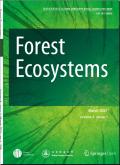土壤水分梯度下欧洲山毛榉(Fagus sylvatica L.)森林细根生物量和形态的动态变化
IF 4.4
1区 农林科学
Q1 FORESTRY
引用次数: 0
摘要
越来越多的证据表明,细根对环境变化特别敏感,这使得它们在应对森林生态系统并使其适应气候变化方面至关重要。然而,我们仍然缺乏对控制细根可塑性的潜在机制的基本理解。以欧洲山毛榉(Fagus sylvatica L.)为研究对象,研究土壤水分变化对其细根动态和形态的影响。研究了近自然成熟山毛榉林细根生物量(FRB)、生产力、死亡率、周转率、比根长(SRL)、比根面积(SRA)和根尖频率(RTF)等性状,并沿土壤水分梯度从干燥、中等和潮湿条件进行了30个月的研究。在三个研究地点进行了顺序根芯取心和随附的土壤测量,反映了土壤水分有效性的梯度。在大多数细根性状上,10 cm土层与10 cm土层之间存在显著差异。各研究点间FRB差异显著,干地FRB最低。然而,生产力、周转量、SRL、SRA和RTF在不同地点之间没有显著差异,但在季节之间具有很高的变异性,表明土壤含水量(SWC)对短期波动的适应,而不是对长期梯度的适应。线性混合模型显示,SWC降低导致SRL、SRA和RTF显著增加(标准化系数分别为- 1.0±0.46、- 1.1±0.46和- 1.1±0.43)。我们的观察表明,山毛榉通过形成薄的吸收根和保持高的季节性可塑性来承受土壤湿度的波动,从而适应土壤水分和干旱的低可用性。通过强调成熟森林对低土壤水分有效性的地下形态适应,我们的研究结果为森林生态系统对气候变化的适应结构和动态提供了新的见解。本文章由计算机程序翻译,如有差异,请以英文原文为准。
Dynamics of fine root biomass and morphology of European beech (Fagus sylvatica L.) forest stands along a soil moisture gradient
Increasing evidence suggests that fine roots are particularly sensitive to environmental changes, making them essential in responding and adapting forest ecosystems to climate change. However, we still lack a fundamental understanding of the underlying mechanisms that control fine root plasticity. The objective of this study was to determine the influence of soil moisture changes on fine root dynamics and morphology of European beech (Fagus sylvatica L.). We conducted a 30-month study of fine root traits, i.e., fine root biomass (FRB), productivity, mortality, turnover, specific root length (SRL), specific root area (SRA), and root tip frequency (RTF), along a soil moisture gradient from dry, intermediate, and wet conditions in a near-natural mature beech forest. Sequential root coring with accompanying soil measurements was carried out at three study sites reflecting the gradient in soil water availability. For most fine root traits, we found significant differences between the upper 10 cm and lower soil depths. FRB showed significant differences between study sites, with the lowest FRB at the dry site. However, productivity, turnover, SRL, SRA, and RTF showed no significant differences between sites, but a high variability between seasons, suggesting an adaptation to short-term fluctuations but not to long-term gradients in soil water content (SWC). Linear mixed models revealed that decreasing SWC led to a significant increase in SRL, SRA, and RTF (standardized coefficients: −1.0 ± 0.46, −1.1 ± 0.46, and −1.1 ± 0.43, respectively). Our observations indicate an adaptation strategy of beech to low availability of soil water and drought by forming thin absorptive roots and by maintaining a high seasonal plasticity to tolerate fluctuations in soil moisture. By highlighting the belowground morphological adaptations of mature forests to low soil water availability, our results provide novel insights into the structure and dynamics of forest ecosystem adaptations to climate change.
求助全文
通过发布文献求助,成功后即可免费获取论文全文。
去求助
来源期刊

Forest Ecosystems
Environmental Science-Nature and Landscape Conservation
CiteScore
7.10
自引率
4.90%
发文量
1115
审稿时长
22 days
期刊介绍:
Forest Ecosystems is an open access, peer-reviewed journal publishing scientific communications from any discipline that can provide interesting contributions about the structure and dynamics of "natural" and "domesticated" forest ecosystems, and their services to people. The journal welcomes innovative science as well as application oriented work that will enhance understanding of woody plant communities. Very specific studies are welcome if they are part of a thematic series that provides some holistic perspective that is of general interest.
 求助内容:
求助内容: 应助结果提醒方式:
应助结果提醒方式:


